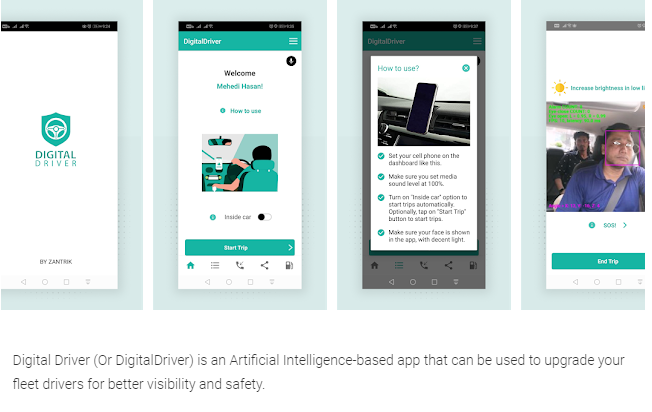Shubho: Zantrik, founded in 2018, is part of BASIS, short for, the
Bangladesh Association of Software and Information Services, the national association of software, information and communication technologies companies. An e-newsletter was sent for companies to participate in an AI programme. This was very timely as we were in the midst of developing the Digital Driver app and were looking for mentorship to better implement AI solutions for the app. We expressed our interest and were delighted to be selected.
2. Share with us the thought process behind creating such an app?
Interestingly, the cause of such frequent accidents in Bangladesh is attributed to a number of factors. The main one being, t
hat drivers do not usually drive their own cars. Unlike Singapore or most dense cities where vehicle owners are the ones behind the wheel, in Bangladesh, a different reality beckons -
95% of the time, a chauffeur is always hired. Coupled by the fact that often, drivers will have to
drive through the night for many hours to get from point A to point B in Bangladesh, spells a recipe for a sleepy abode. Furthermore, based on findings, there are about 1 billion traditional vehicles
in the world that do not have the latest in-built functions, such as a rearview camera and in Bangladesh alone, most cars are imported from Japan and are already 7 years old. Besides alerting the driver, the benefits are two-way:
A vehicle owner can have his or her chauffeur/driver download the app to get these alerts. A typical scenario would be a chauffeur who is off to pick up the children after school and these are the alerts that a vehicle owner may get:
"Hey, your chauffeur/driver is feeling sleepy!"
"Hey, your chauffeur/driver is speeding!"
"Hey, your chauffeur/driver is ferrying three passengers right now."
The app would also share accidents and barriers on any given route through an advanced algorithm and works for bigger model vehicles such as trucks and buses.
3. Was Zantrik undergoing digital transformation and what was the motivation behind undertaking the AI programme by NUS-ISS eGL?
Shubho: Zantrik prides itself on automation so that everything can be done in an optimised manner with minimal effort. We have internal sales systems, tasks management system and even a fleet management system for B2B companies. The idea for the Digital Driver app came about even before the LICT programme and was developed as a result of a common concern - the lingering thought on whether our chauffeurs are driving safe and maintaining our vehicles' well. With proper driving being a big part of vehicle maintenance, we thought,
why not build something that could help drivers, drive better?
4. Describe the learning experience with NUS-ISS.
Shubho: It was a perfect match for the Zantrik team to be taught by NUS-ISS' lecturers, as it turned out to be a great acceleration for us to bring the app to fruition while learning about best technological practices and available resources. Honestly, if we were not selected, we may have taken another six months to launch it and we are truly grateful for the opportunity and proactive mentorship by NUS-ISS' eGL team and the Artificial Intelligence Practice team. We found the lecturers extremely helpful, especially their enthusiasm and positivity in getting us on track. Till now, we stay in touch with our lecturers and they would not hesitate to offer their time to help and advise.
5. Was the online learning journey a challenge for you and your team?
Shubho: One year ago, I would have said that I preferred face to face classes. However having been through online learning, I must say that I do not see any difference. My team learnt to adapt and remained productive and results driven.
 A screenshot of the Digital Driver app and its functions.
6. Share an example of the skills you learnt during your training being directly applied to the app?
Shubho:
A screenshot of the Digital Driver app and its functions.
6. Share an example of the skills you learnt during your training being directly applied to the app?
Shubho: We received great help in two areas which we were struggling the most. #1 To implement an advanced AI processing app on a smartphone, which has limited capability and resources as compared to a server and #2 getting the right algorithm for human gesture recognition. The NUS-ISS' lecturers helped by sharing vastly on the technological aspects and deciding the right strategy to move forward by laying out the do's and don'ts. We are elated over the various technolgical milestones achieved and look forward to the far-reaching impact of the app.
7.What future plans do you have for the app?
Shubho: Future markets in the pipeline include USA and Southeast Asian Countries such as Indonesia, Thailand, Vietnam.
Digital Driver's reporting capability could also enable us to work with cab hailing apps such as Grab, Gojek or Uber drivers, as an alert to the nearest police station or owner of the car can be triggered, should passengers be detected as displaying threatening behaviours. Grab worldwide, may also be interested to work with us as well, as they can receive detailed insights on their drivers to derive better ratings for them through the Digital Driver app.
Footnote: The Digital Driver app prior to launch was conceptualised as the DriveSafe app.
More about the NUS-ISS eGL and LICT partnership
NUS-ISS' eGL has had a seven year collaboration with Leveraging on ICT (LICT) a programme under the Ministry of ICT Division, the government of Bangladesh. LICT, engages over 600 officers from Public Sector and 100 from the IT and ITES industry in Bangladesh. This specific AI programme was carefully curated to accelerate the skills in Artificial Intelligence for 50 participants from 10 IT & ITES companies where Zantrik was one of them. For mentoring and advisory collaboration and opportunities, email the e-Government Leadership Centre at:
egl-enquiries@nus.edu.sg.